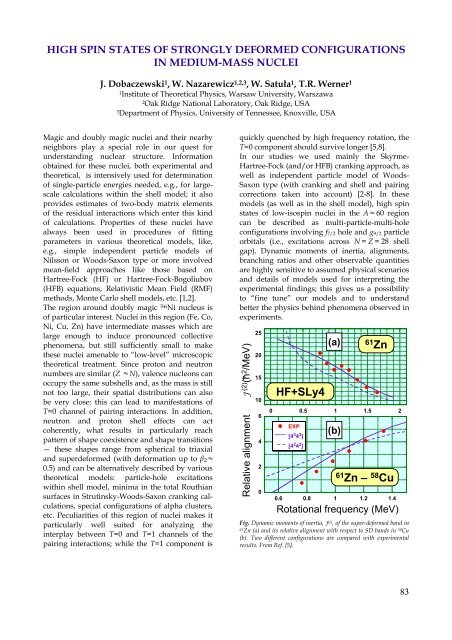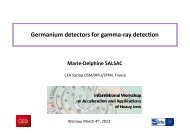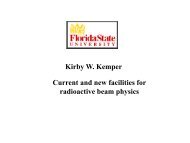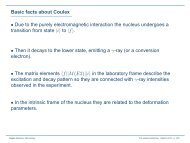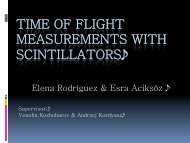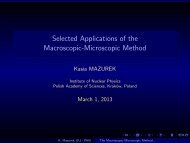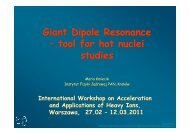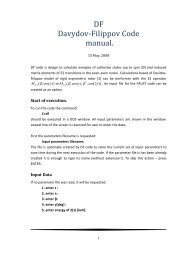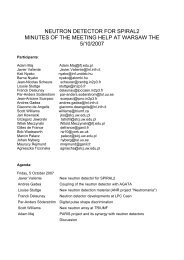[1] J. Dobaczewski, J. Dudek, Comp. Phys. Comm. 102, 166 (1997); 102, 183 (1997); 131, 164 (2000).[2] J. Dobaczewski, P. Olbratowski, Comp. Phys. Comm. 158, 158 (2004); 167, 214 (2005).[3] P. Olbratowski, J. Dobaczewski, J. Dudek, T. Rząca-Urban, Z. Marc<strong>in</strong>kowska, R.M. Lieder, Acta Phys.Pol. B33, 389 (2002).[4] P. Olbratowski, J. Dobaczewski, J. Dudek, W. Płóciennik, Phys. Rev. Lett. 93, 052501 (2004).[5] P. Olbratowski, J. Dobaczewski, J. Dudek, Phys. Rev. C73, 054308 (<strong>2006</strong>).[6] P. Olbratowski, J. Dobaczewski, P. Powałowski, M. Sadziak, K. Zberecki, Int. J. of Mod. Phys. E15, 333(<strong>2006</strong>).[7] J. Dudek, J. Dobaczewski, N. Dubray, A. Góźdź, V. Pangon, N. Schunck, Int. J. Mod. Phys. E16, 516(2007).[8] K. Zberecki, P. Magierski, P.-H. Heenen, N. Schunck, Phys.Rev. C74, 051302 (<strong>2006</strong>).[9] K. Zberecki, P. Magierski, P.-H. Heenen, N. Schunck, Int. J. Mod. Phys. E16, 533 (2007).[10] N. Schunck, P. Olbratowski, J. Dudek, J. Dobaczewski, Int. J. of Mod. Phys. E15, 490 (<strong>2006</strong>).[11] J. Dudek, D. Curien, N. Dubray, J. Dobaczewski, V. Pangon, P. Olbratowski, N. Schunck, Phys. Rev.Lett. 97, 072501 (<strong>2006</strong>).82
HIGH SPIN STATES OF STRONGLY DEFORMED CONFIGURATIONSIN MEDIUM-MASS NUCLEIJ. Dobaczewski 1 , W. Nazarewicz 1,2,3 , W. Satuła 1 , T.R. Werner 11 Institute of Theoretical Physics, Warsaw University, Warszawa2 Oak Ridge National Laboratory, Oak Ridge, USA3 Department of Physics, University of Tennessee, Knoxville, USAMagic and doubly magic nuclei and their nearbyneighbors play a special role <strong>in</strong> our quest forunderstand<strong>in</strong>g <strong>nuclear</strong> structure. Informationobta<strong>in</strong>ed for these nuclei, both experimental andtheoretical, is <strong>in</strong>tensively used for determ<strong>in</strong>ationof s<strong>in</strong>gle-particle energies needed, e.g., for largescalecalculations with<strong>in</strong> the shell model; it alsoprovides estimates of two-body matrix elementsof the residual <strong>in</strong>teractions which enter this k<strong>in</strong>dof calculations. Properties of these nuclei havealways been used <strong>in</strong> procedures of fitt<strong>in</strong>gparameters <strong>in</strong> various theoretical models, like,e.g., simple <strong>in</strong>dependent particle models ofNilsson or Woods-Saxon type or more <strong>in</strong>volvedmean-field approaches like those based onHartree-Fock (HF) or Hartree-Fock-Bogoliubov(HFB) equations, Relativistic Mean Field (RMF)methods, Monte Carlo shell models, etc. [1,2].The region around doubly magic 56 Ni nucleus isof particular <strong>in</strong>terest. Nuclei <strong>in</strong> this region (Fe, Co,Ni, Cu, Zn) have <strong>in</strong>termediate masses which arelarge enough to <strong>in</strong>duce pronounced collectivephenomena, but still sufficiently small to makethese nuclei amenable to “low-level” microscopictheoretical treatment. S<strong>in</strong>ce proton and neutronnumbers are similar (Z ≈ N), valence nucleons canoccupy the same subshells and, as the mass is stillnot too large, their spatial distributions can alsobe very close: this can lead to manifestations ofT=0 channel of pair<strong>in</strong>g <strong>in</strong>teractions. In addition,neutron and proton shell effects can actcoherently, what results <strong>in</strong> particularly reachpattern of shape coexistence and shape transitions— these shapes range from spherical to triaxialand superdeformed (with deformation up to β 2 ≈0.5) and can be alternatively described by varioustheoretical models: particle-hole excitationswith<strong>in</strong> shell model, m<strong>in</strong>ima <strong>in</strong> the total Routhiansurfaces <strong>in</strong> Strut<strong>in</strong>sky-Woods-Saxon crank<strong>in</strong>g calculations,special configurations of alpha clusters,etc. Peculiarities of this region of nuclei makes itparticularly well suited for analyz<strong>in</strong>g the<strong>in</strong>terplay between T=0 and T=1 channels of thepair<strong>in</strong>g <strong>in</strong>teractions; while the T=1 component isquickly quenched by high frequency rotation, theT=0 component should survive longer [5,8].In our studies we used ma<strong>in</strong>ly the Skyrme-Hartree-Fock (and/or HFB) crank<strong>in</strong>g approach, aswell as <strong>in</strong>dependent particle model of Woods-Saxon type (with crank<strong>in</strong>g and shell and pair<strong>in</strong>gcorrections taken <strong>in</strong>to account) [2-8]. In thesemodels (as well as <strong>in</strong> the shell model), high sp<strong>in</strong>states of low-isosp<strong>in</strong> nuclei <strong>in</strong> the A ≈ 60 regioncan be described as multi-particle-multi-holeconfigurations <strong>in</strong>volv<strong>in</strong>g f 7/2 hole and g 9/2 particleorbitals (i.e., excitations across N = Z = 28 shellgap). Dynamic moments of <strong>in</strong>ertia, alignments,branch<strong>in</strong>g ratios and other observable quantitiesare highly sensitive to assumed physical scenariosand details of models used for <strong>in</strong>terpret<strong>in</strong>g theexperimental f<strong>in</strong>d<strong>in</strong>gs; this gives us a possibilityto “f<strong>in</strong>e tune” our models and to understandbetter the <strong>physics</strong> beh<strong>in</strong>d phenomena observed <strong>in</strong>experiments.J (2) --(h 2 /MeV)Relative alignment252015106420EXP[4 3 4 2 ][4 2 4 2 ]HF+SLy40 0.5 1 1.5 2EXP[4 3 4 2 ][4 2 4 2 ]CZ1327777Z1227A77(a)(b)61Zn61Zn – 58 Cu0.6 0.8 1 1.2 1.4Rotational frequency (MeV)Fig. Dynamic moments of <strong>in</strong>ertia, J (2) , of the super-deformed band <strong>in</strong>61Zn (a) and its relative alignment with respect to SD bands <strong>in</strong> 58 Cu(b). Two different configurations are compared with experimentalresults. From Ref. [5].83
- Page 3:
NUCLEAR PHYSICSIN POLAND1996-20063
- Page 6 and 7:
Report of Polish Nuclear Physics Ne
- Page 8 and 9:
4• The isoscalar bosons in nuclea
- Page 10 and 11:
6• Application of the Mössbauer
- Page 13 and 14:
POLISH NUCLEAR PHYSICS NETWORKJerzy
- Page 15 and 16:
Fig. 4. AIC-144, K=60 light particl
- Page 17:
OVERVIEW PAPERS13
- Page 20 and 21:
A successfulstudy on the decay ofpr
- Page 22 and 23:
visible light and a CCD camera will
- Page 24 and 25:
the heavy ion cyclotron up to an en
- Page 26 and 27:
investigated by means of ALICE and
- Page 28 and 29:
and/or baryon density of the nuclea
- Page 30 and 31:
Figure 5. Top: K - /K + ratio in Ni
- Page 32 and 33:
Acknowledgements: I would like to t
- Page 34 and 35:
7%6%5%4%3%2%1%0%8%7%6%5%4%3%2%1%0%E
- Page 37 and 38: NUCLEAR PHYSICS IN POLAND - APPLICA
- Page 39 and 40: Funds of the European Union foresee
- Page 41 and 42: POSSIBLE LOCATION FOR THE UNDERGROU
- Page 43 and 44: Fig. 5. Time dependence of maximume
- Page 45: CONTRIBUTIONS41
- Page 48 and 49: [1] K. Pomorski, B. Nerlo-Pomorska,
- Page 50 and 51: [1] K. Pomorski and J. Dudek, Phys.
- Page 52 and 53: [1] J. Jastrzębski, H. Daniel, T.
- Page 54 and 55: [1] P.Adrich, A.Klimkiewicz, M. Fal
- Page 56 and 57: [4] J. Dobaczewski, W. Nazarewicz,
- Page 58 and 59: [1] A. Sobiczewski, F.A. Gareev, B.
- Page 60 and 61: [1] R. Smolańczuk, Phys. Rev. C 56
- Page 62 and 63: [1] W.J. Świątecki, K. Siwek-Wilc
- Page 64 and 65: [1] J. Peter, N. Alamanos, N. Amar,
- Page 66 and 67: [1] R. Broda, J. Phys. (London) G32
- Page 68 and 69: 1. J. Styczeń, J. Chevallier, B. H
- Page 70 and 71: [1] E. Grodner, J. Srebrny, Ch. Dro
- Page 72 and 73: [1] C.Plettner, L.Batist, J.Doring,
- Page 74 and 75: [1] W. Kurcewicz, Hyperfine Interac
- Page 76 and 77: [1] M. Sugawara, Y. Toh, T.Czosnyka
- Page 78 and 79: [1] M.Loewe, J.de Boer, H.J.Maier,
- Page 80 and 81: [1] S.G. Rohoziński, K. Starosta,
- Page 82 and 83: [1] B. Nerlo-Pomorska, K. Pomorski,
- Page 84 and 85: [1] L.Próchniak, K.Zając, K.Pomor
- Page 88 and 89: [1] W. Nazarewicz, J. Dobaczewski,
- Page 90 and 91: [1] L. Próchniak, P. Quentin, D. S
- Page 92 and 93: [1] K. Zając, Acta Phys. Pol. B34,
- Page 94 and 95: [1] L. Próchniak, K. Zając, K. Po
- Page 96 and 97: [1] A.Maj, M.Kmiecik, F.Camera, B.H
- Page 98 and 99: [1] M.Kicińska-Habior, K.A.Snover,
- Page 100 and 101: [1] P.Adrich, A.Klimkiewicz, M. Fal
- Page 102 and 103: [1] K. Czerski, H. Bucka, P. Heide
- Page 104 and 105: [1] C.R Bingham, M.N. Tantawy, J.C.
- Page 107 and 108: NUCLEAR OPEN QUANTUM SYSTEM MANY-BO
- Page 109 and 110: THREE-NUCLEON FORCE EFFECTS IN NUCL
- Page 111 and 112: RELATIVISTIC EFFECTS IN THREE-NUCLE
- Page 113 and 114: ELECTRON AND PHOTON SCATTERING ON T
- Page 115 and 116: EXPERIMENTAL STUDIES OF THREE-NUCLE
- Page 117 and 118: A SEARCH FOR MAJORANA NEUTRINOExper
- Page 119 and 120: DOUBLE BETA DECAY MATRIX ELEMENTS I
- Page 121 and 122: NEUTRINOLESS DOUBLE BETA DECAYIN SU
- Page 123 and 124: FUSION BARRIER DISTRIBUTIONSP.Czosn
- Page 125 and 126: NUCLEAR OPTICAL POTENTIAL FROM LIGH
- Page 127 and 128: REACTIONS WITH LOOSELY BOUND PROJEC
- Page 129 and 130: NEUTRON-INDUCED REACTIONSJ. Andrzej
- Page 131 and 132: NUCLEAR FUSION AND FISSION IN MEAN-
- Page 133 and 134: FISSION AND FUSION OF NUCLEI WITHIN
- Page 135 and 136: ENHANCED ELECTRON SCREENING IN DEUT
- Page 137 and 138:
EXPERIMENTAL APPROACHES TO HEAVY IO
- Page 139 and 140:
HEAVY ION EXPERIMENTS AT LNS CATANI
- Page 141 and 142:
HEAVY ION REACTION MECHANISMS AT FE
- Page 143 and 144:
HARD PHOTONS FROM NUCLEUS-NUCLEUSAN
- Page 145 and 146:
NEUTRAL MESON PRODUCTION AND BARYON
- Page 147 and 148:
CORRELATIONS AND FLUCTUATIONS IN HE
- Page 149 and 150:
MASS AND ISOTOPIC EFFECTS IN NUCLEA
- Page 151 and 152:
NUCLEAR MATTER AT THE LIQUID-GAS PH
- Page 153 and 154:
HEAVY-ION COLLISIONS: GEOMETRY AND
- Page 155 and 156:
MULTIFRAGMENTATION IN HEAVY-ION COL
- Page 157 and 158:
ULTRA-RELATIVISTIC REACTIONS BETWEE
- Page 159 and 160:
INVESTIGATION OF HADRON PROPERTIES
- Page 161 and 162:
SPALLATION AND FRAGMENTATION OF ATO
- Page 163 and 164:
STRANGE-PARTICLE PRODUCTION IN NUCL
- Page 165 and 166:
PHASE TRANSITIONS IN HIGHLY EXCITED
- Page 167 and 168:
NUCLEAR SINGLE PARTICLE SUM RULES I
- Page 169 and 170:
FLUCTUATIONS AND SEARCH FOR THE CRI
- Page 171 and 172:
BETWEEN NUCLEAR AND ELEMENTARY INTE
- Page 173 and 174:
INVESTIGATION OF CHARGE AND ISOSPIN
- Page 175 and 176:
NUCLEAR STATES OF η, K MESONS, Σ
- Page 177 and 178:
HYPERON RESONANCES PRODUCED IN PROT
- Page 179 and 180:
NONMESONIC DECAY OF Λ - HYPERON IN
- Page 181 and 182:
INTERACTION OF THE η AND η΄ MESO
- Page 183 and 184:
INVESTIGATION OF THE HYPERON-NUCLEO
- Page 185 and 186:
η AND η΄ MESONS PRODUCTION IN D-
- Page 187 and 188:
K+ PRODUCTION IN PROTON-NUCLEUS REA
- Page 189 and 190:
INTERACTION OF K + K - MESONSJ. Bal
- Page 191 and 192:
PRODUCTION OF K+ AND K- MESONS IN H
- Page 193 and 194:
AT THE BORDER BETWEEN ATOMIC AND NU
- Page 195 and 196:
ATOMIC PHYSICS IN HEAVY ION - ATOM
- Page 197 and 198:
PRECISION TESTS OF THE STANDARD MOD
- Page 199 and 200:
SEARCH FOR TIME REVERSAL VIOLATION
- Page 201 and 202:
HIGH INTENSITY ULTRA-COLD NEUTRON S
- Page 203 and 204:
NUCLEAR PHYSICS WITH ULTRACOLD ATOM
- Page 205 and 206:
FORWARD SPECTROMETER FOR PANDAD. Gi
- Page 207 and 208:
DESIGN STUDIES OF CHARMONIUM DETECT
- Page 209 and 210:
ONLINE EVENT SELECTION IN THE CBM E
- Page 211 and 212:
DEVELOPMENT OF A FAST DATA READOUT
- Page 213 and 214:
NEW TECHNOLOGIES OF SILICON DETECTO
- Page 215 and 216:
NUCLEAR REACTIONS IN THE ACCELERATI
- Page 217 and 218:
NATURAL RADIOACTIVITY STUDIES IN SO
- Page 219 and 220:
APPLICATION OF THE MÖSSBAUER SPECT
- Page 221 and 222:
POSITRON ANNIHILATION LIFETIME SPEC
- Page 223 and 224:
VALIDATION OF NUCLEAR DATA AND MODE
- Page 225 and 226:
LOOK TO THE FUTURE: NUCLEARPHYSICS
- Page 227 and 228:
LONG-RANGE PLAN OF POLISH NUCLEAR P
- Page 229 and 230:
225
- Page 231 and 232:
THE OUTLINE OF BUDGET EXPENDITUREST
- Page 233 and 234:
INSTITUTION AND AUTHORINDEXES229
- Page 235 and 236:
INSTITUTION INDEXAA. Sołtan Instit
- Page 237 and 238:
Kistryn, S, 111, 157, 169, 193, 195
- Page 239 and 240:
UNITS OF POLISH NUCLEAR PHYSICSNETW
- Page 241 and 242:
POLISH NUCLEAR PHYSICS NETWORKList
- Page 243 and 244:
LIST OF ELECTRONIC ADDRESSES239
- Page 245 and 246:
Nuclear Physics community in Poland
- Page 247 and 248:
Faculty of Physics and Applied Info
- Page 249 and 250:
Kurpeta Jan jkurpeta@mimuw.edu.plMa
- Page 251 and 252:
Gil Damian damian.gil@if.uj.edu.plG
- Page 253 and 254:
Nuclear Physics community in Poland
- Page 255 and 256:
Kopeć Mariusz AGH FPACS mariusz@no
- Page 257 and 258:
Rząca-Urban Teresa IEP UW rzaca@@f
- Page 259 and 260:
Białkowska Helena IPJ Helena.Bialk
- Page 261 and 262:
Krauze Maciej IP US meszik@nuph.us.
- Page 263 and 264:
Słowiński Bronisław PhF WUT slow
- Page 265 and 266:
AGH FPACS - AGH University of Scien


